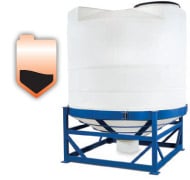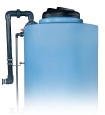How to Evaluate Cone-bottom Storage Tank Solutions
Cone-bottom tanks are generally used in process applications where total drainage of the tank is required. Typical applications would include the storage of heavy materials and materials prone to sludging, which are difficult to drain out of upright tanks.

Cone-bottom tanks are also ideal for dry materials, such as grains or cattle feed as they can be 100% drained out of the tank with a flange or slidegate at the bottom of the tank. In addition, materials that require separation can be handled with a decant fitting to remove the liquid from the solids.
Let’s take a look at some key considerations for evaluating cone-bottom tank storage solutions — and attractive alternatives.
Support Mechanisms For Cone-Bottom Tanks
 The correct support of a cone-bottom tank is vital to preventing spills and damage to the tank, and to ensuring safe and effective operation. Seismic ratings should also be considered, depending on the area where the tank will be installed.
The correct support of a cone-bottom tank is vital to preventing spills and damage to the tank, and to ensuring safe and effective operation. Seismic ratings should also be considered, depending on the area where the tank will be installed.
The support structure usually consists of an epoxy coated carbon steel stand and basket that supports the tank. The basket must fit properly around the tank with no large gaps. The basket must also be strong enough to support the weight of the materials under storage. Reinforced support or a full pan bottom support may be required for heavier materials or storage applications that include elevated temperatures.
In addition to the epoxy coated carbon steel, other basket and support materials such as stainless steel, are available.
Proper Slope of the Cone-Bottom Tank
The slope of the tank impacts the rate and efficiency at which stored material can exit the tank. The materials stored and the size of the tank will dictate the slope of the tank. Dry and liquid materials require less slope, while heavy, sludgy materials require a steeper tank slope design to facilitate ease of draining.
Tank slopes of 30, 45, and 60 degrees, and a variety of tank sizes are available. Please refer to our cone-bottom tank specifications page for more information.
Limitations of Cone-bottom Tanks
While cone-bottom tanks have been the industry standard in full-drain solutions for decades, they may not suit every need in every storage application. For example, cone-bottom tanks require plenty of overhead clearance to make room for the cone — as much as twenty feet or more depending on the tank being installed. They also often need additional maintenance such as repainting and recoating.
Cone-bottom tanks require a basket and a stand, adding cost and equipment to your system. If your operation is in an earthquake zone, the basket and stand will need to be seismically rated, adding bulk and expense.
An Attractive Alternative to Cone-Bottom Tanks
.jpg?width=209&height=256&name=IMG_0070%20(522x640).jpg) When full tank drainage is required, Poly Processing’s IMFO® or sloped bottom IMFO® offers an excellent alternative to the standard cone-bottom tank.
When full tank drainage is required, Poly Processing’s IMFO® or sloped bottom IMFO® offers an excellent alternative to the standard cone-bottom tank.
Traditional tank maintenance can be a challenge with many chemicals — so Poly Processing has designed and engineered a unique sloped bottom tank system that greatly minimizes the hazards associated with traditional vertical tank maintenance.
With Poly Processing’s Sloped Bottom Integrally Molded Flanged Outlet tank, or IMFO® system, the flange is molded while the tank is processing, making it a stress-free part of the tank. The floor of the tank is sloped towards the IMFO giving you the greatest possible full drain system in a vertical tank design.
 The Sloped Bottom IMFO’s advantages are many:
The Sloped Bottom IMFO’s advantages are many:
- The flange is at the bottom of the tank and the tank floor is sloped, therefore complete full drainage is achieved below the tank knuckle radius, which eliminates the need to enter the tank for cleaning.
- One-piece construction enhances long-term performance of the tank, since it doesn’t compromise the tank hoop’s integrity or structural design.
- In aggressive applications, the complete flange face is protected by the antioxidant OR-1000™ system.
- The Sloped Bottom IMFO allows even heavier materials such as sludge, FOG, and thicker chemicals to discharge completely.
The Sloped Bottom IMFO® system is also much more cost effective than a cone bottom tank. It delivers full tank discharge without the need for a steel tank stand and basket. This eliminates maintenance work on the basket and stand, therefore reducing upfront costs and tank operating costs.
For more information about cone-bottom and slope-bottom IMFO tanks, please refer to the technical specifications document, or contact a Poly Processing storage tank system specialist.
- April 14, 2025
- Topics: Applications
About Poly Processing
Posts By Topic
Tech Talk Podcast Episodes
Subscribe By Email
Recent Posts
- Installation Tips for Chemical Storage Tanks: Site Preparation and Offloading
- Understanding pH and Chemical Concentration When Choosing a Chemical Tank
- Maximizing Fill Efficiency: Selecting the Optimal Fill Line System
- Chemical Storage Tanks: A Quick Guide for End Users
- Popular Customization Options for Chemical Storage Tanks
Tank Configurator

Find the recommended tank and system components for your chemical storage challenge.
Configure a Tank Package







